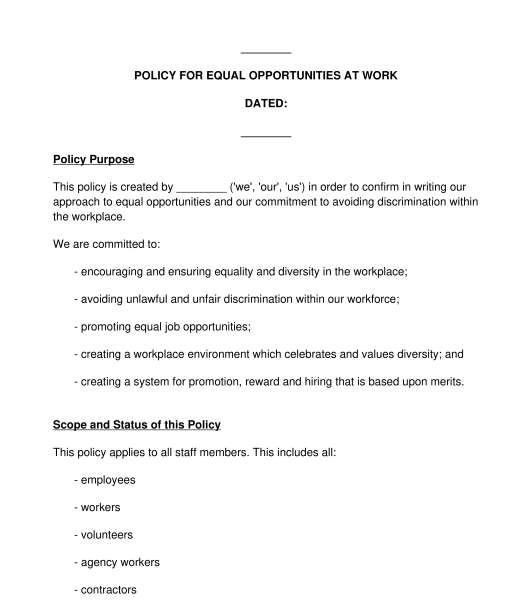 25/09/2025
25/09/2025

Answer a few questions and your document is created automatically.

Your document is ready! You will receive it in Word and PDF formats. You will be able to modify it.

 25/09/2025
25/09/2025
 Word and PDF
Word and PDF
 5 to 7 pages
5 to 7 pages
An equal opportunity policy is used by an employer to explain how it ensures equal opportunities within the workplace. This type of policy outlines the approach an employer shall take to ensure that staff members do not suffer unfair and unlawful discrimination. This policy is suitable for use where the employer is based in Great Britain.
No. In general, it is not a legal obligation for an employer to hold a policy of this type.
It is however important to note that the law which is relevant to equality explicitly prohibits discrimination, harassment and victimisation in an employment setting. Furthermore, a statutory code of practice has been created by the Equality and Human Rights Commission to help employers use equality laws properly. This code recommends that employers should hold this type of policy.
Discrimination means treating somebody less favourably than someone else because of their:
Less favourable treatment means putting somebody at a disadvantage. This can include things like:
If an employer formally recognises a trade union or staff association, they may wish to consult and agree on the terms of the policy with them. If a collective agreement* is in place between the employer this may be a legal requirement.
A collective agreement is a written contract that is negotiated between a union and an employer on behalf of its union members.
The policy document should be communicated to all staff members. It should be made easily accessible to all staff members. It is common to display workplace policies in an easily accessible public area, or within a staff handbook.
It is also useful for employers to hold other relevant policy documents which may be read in conjunction with and may refer to the equal opportunities policy. For example, this may include:
The policy can remain in place indefinitely. However, it is important to make sure that the policy is reviewed and kept up to date, as appropriate. Should the policy be revised or altered, these revisions and alterations must be communicated to employees at the earliest opportunity.
The policy will provide:
The main piece of legislation that governs equal opportunities in the workplace is the Equality Act 2010. In particular, Part 5 places obligations upon employers.
The Equality and Human Rights Commission (EHRC) is an independent statutory body that is responsible for overseeing equality and divesting in Britain. The EHRC has enforcement powers. A statutory code of practice for employees is available on the EHRC website.
You fill out a form. The document is created before your eyes as you respond to the questions.
At the end, you receive it in Word and PDF formats. You can modify it and reuse it.
Guides to help you
Equal Opportunities Policy - Template - Word & PDF
Country: United Kingdom